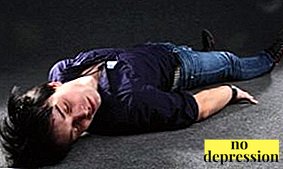Alcoholic epilepsy is a separate form of common disease.
There are certain symptoms by which can detect the presence of the disease in person.
General information about the disease

What it is?
Alcoholic epilepsy - A painful condition, accompanied by severe attacks (convulsive, non-convulsive).
The main cause of seizures is alcohol addiction.
It can be caused by a stable dependence, and it can occur without it with a single intake of alcohol.
As a rule, this type of epilepsy is caused more often. alcohol addiction stage 2-3. One-off manifestations are much less common and are associated with a significant excess of the limit of the permissible dose of strong drink.
The danger of the condition is not only in its general negative effect on the body, but also in the possible adverse effects of the attack - falls, blows.
Causes
The main reason - long-term alcohol poisoning, which leads to intoxication of the body. As a result of poisoning, there is a disruption in the work of the whole human body, including the nervous system.

The risk of epileptic seizures is especially high if a person consumes low-quality strong drinks - surrogates, meth.
Such drinks contain a lot of fusel oils, other toxic impurities.
Collateral causesthat can trigger seizures are:
- head injuries;
- infectious diseases;
- atherosclerosis.
If a person abusing alcohol, once had an epileptic seizure, it can happen again. Moreover, as the situation worsens, the frequency of attacks will increase.
Gradually, epilepsy becomes stable and then the likelihood of seizures not directly associated with spirits.
In this case, even with complete weaning from the habit, seizures caused by irreversible changes in human health can occur.
Classification
In modern medicine, it is customary to distinguish the following forms of the actual epileptic disease:
- Idiopathic. In this group, the types of the disease are distinguished, which differ from each other in their symptoms and the typical age of appearance of the first attacks.
- Symptomatic. Acquired form of the disease (characteristic of the alcoholic variety). Manifested as a result of damage and abnormalities outside the neuron, disrupting its functioning and reducing the epileptogenic threshold.
- Cryptogenic. Equivalent symptomatic form, but not justified today in terms of the cause of the occurrence.

If we talk about the classification of directly alcoholic epilepsy, in the scientific literature it is customary to single out three similar pathological conditions. They are united in one general concept of "alcoholic epilepsy", but there are some differences:
- Epileptic reaction. One-time, episodic seizures in people who are not addicted, appear after they take alcohol.
Usually such reactions can be observed the next day during a hangover, when the body is severely weakened and toxic substances are still in the blood.
As soon as the symptoms of a hangover subside, the reactions disappear.
- Epileptic syndrome. Manifested with systematic alcoholism. Attacks occur repeatedly, accompanied by serious violations in the body of various kinds.
 The nature of the observed violations corresponds to the general pattern of manifestations of alcohol dependence. There may be hallucinations.
The nature of the observed violations corresponds to the general pattern of manifestations of alcohol dependence. There may be hallucinations. - Alcoholic epilepsy. It is usually diagnosed in people who have led the wrong lifestyle for at least ten years. Attacks are acute, develop into states of psychosis.
Symptoms
Clinical manifestations Partially similar to the symptoms of normal seizures:
- loss of consciousness;
- the appearance of muscle cramps;
- pale complexion;
- blueness around the mouth;
- rolling eyes;
- the appearance of foam, vomiting;
- unmonitored movement.
But there is a number of additional features of the course of the disease in addicts. In this case, more pronounced negative phenomena are added to the standard symptoms:
- personality disorders (bitterness, sensitivity, inattention);
- behavior disorders;
- loss of memory;
- speech problems;
- loss of interest in life;
- tendency to depression;
- insomnia;
- suicidal tendencies.

The most common symptoms of the disease can be observed in persons 27-45 years oldwhose experience systematic use of alcoholic beverages is at least 7 years.
However, cases of the occurrence of the disease and in patients who consume alcohol on a regular basis from 2 years are often observed.
Signs before an attack
The following signs indicate the imminent onset of an attack.:
- muscle cramps;
- chest spasm;
- hoarse breathing;
- shout;
- pale skin;
- blue lips.

Often, patients experiencing a seizure, throws back his head.
In the absence of timely assistance, the situation can be fatal, as there is a risk of language sinking and respiratory arrest.
When the seizure ends, the person feels weakness, fatigue. However, he does not remember what happened to him.
Persons with addiction may develop persistent insomnia. There are realistic hallucinations, unnecessarily colorful dreams, early awakenings.
Symptoms of an upcoming significant seizure may occur in the few days preceding it. This may be irritability, insomnia, problems with appetite, headache, general malaise.
Likely consequences
During seizures, there is a risk of injury, since the person is completely loses control of himself.
In this situation, the presence of a number of people who can provide assistance is of great importance.
The main danger of the disease - Pathological changes in the psyche. In the absence of the necessary treatment, a person undergoing systematic seizures develops brain damage.

In some places of the brain appear necrotic changes.
As a result, there is a violation of thought processes, distortion of the patient's personality.
Also, persons suffering from this form of the disease have a risk of epileptic status.
This is a critical condition in which a new attack occurs at an alarming frequency (every few minutes).
As a result, there are risks of respiratory failure, cardiac arrest, brain edema, entry into a state of coma. Similar situations represent serious threat.
Diagnostics
To date there are no methodsable to determine whether the patient is just the alcoholic form of the disease.
But for individual signs and information received from the patient himself and his relatives, it is easy to identify the problem.
First of all the doctor collecting history and clarifies the following information:
- the presence of seizures;
- duration of seizures;
- features of the patient's sleep (talk, flinching, etc.).
After the preliminary diagnosis of the patient is sent to additional laboratory, instrumental examinations:
- blood test;
- Analysis of urine;
- Magnetic resonance imaging;
- CT scan;
- electroencephalogram (of particular importance are the results obtained during the hour that has passed since the attack).
After obtaining the necessary results confirming the initial suspicions, the specialists proceed to the treatment.
First aid

Great importance for reducing the risk of injury to a person during an attack has providing competent assistance to nearby persons.
Often, people faced with an unexpected situation, are confused and do not know how to help the victim.
It is important to understand that wrong actions can harmrather than help.
Providing first aid It is important to adhere to the following recommendations.:
- put a person on a horizontal surface;
- gently hold your head;
- turn your head to the side (so that a person does not choke in a supine position with his own vomit);
- do not hold the tongue, do not open the teeth of a person (you can cause injury through careless actions);
- do not hold limbs;
- remove all dangerous items in the access area.
Treatment methods
Effective treatment is possible. in the hospitalwhere the patient will be under the supervision of specialists.
To achieve positive results is possible only when getting rid of the cause of the attacks - alcohol addiction.
Complex therapy of alcoholism, which is the main disease, should be accompanied by the desire of the patient himself to overcome addiction and begin to lead a full-fledged lifestyle.
Without an objective recognition of the existing problem and efforts to eradicate it, it is impossible to achieve a positive result.

Directly relief of attacks It is produced with the help of preparations used for ordinary patients with epilepsy.
These are anticonvulsant drugs: Carbamazepine, Valproate sodium, Lamotrigine, Ethosuximide, Topiramate and others.
In addition to medication may apply:
- physiotherapy treatment;
- diet food;
- psychotherapy;
- coding from alcoholism.
Prevention and prognosis
In the presence of the disease is important first abandon the use of spirits. The frequency of epileptic seizures in a person with alcohol dependence will only constantly increase.
This can cause brain hemorrhage, necrosis. Such processes lead to mental disorders, motor disorders. Lack of treatment can ultimately be fatal.
Getting rid of alcohol addiction, the use of anticonvulsant drugs, maintaining a proper lifestyle - all these measures will help change the situation avoid catastrophic consequences for the body.
Thus, alcoholic epilepsy is a serious illness. Its course resembles the usual form of the disease. You can only change the situation by alcohol rejectiontaking anticonvulsants.
Epileptic seizures on the background of alcohol withdrawal:

 The nature of the observed violations corresponds to the general pattern of manifestations of alcohol dependence. There may be hallucinations.
The nature of the observed violations corresponds to the general pattern of manifestations of alcohol dependence. There may be hallucinations.

